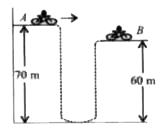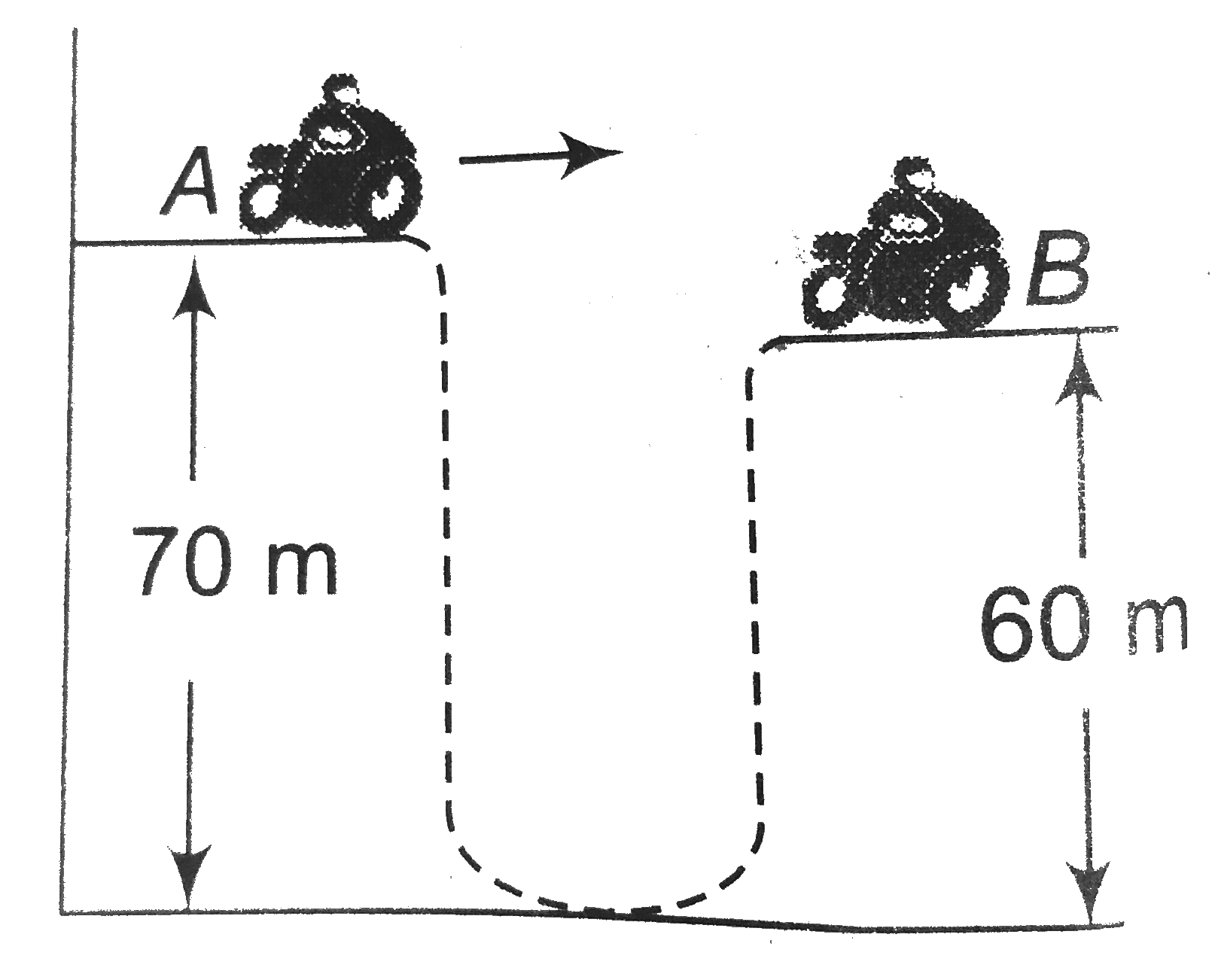A motor cyclist is trying to jump across a path as shown by driving horizontally off a cliff A at a speed of 5ms−1. Ignore air resistance and take g=10ms−2. The speed with which he touches the cliff B is

2.0ms−1
12ms−1
25ms−1
15ms−1
The correct Answer is:D
Speed in horizontal direction remains constant during whole journey because there is no acceleration in this direction.
So, v1=5ms−1
In vertical direction
Loss of gravitational potential energy = gain in kinetic energy
∴mgh=12mv22
or v22=2gh=2×10×(70−60)=200
Hence , the speed with which he touches the cliff B is
v=√v21+v22=√25+200=√225=15ms−1.
Topper's Solved these Questions
- WORK, ENERGY AND POWERBOOK - MTG GUIDECHAPTER - WORK, ENERGY AND POWEREXERCISE - NEET CAFE (TOPICWISE PRACTICE QUESTIONS) (MOTIN IN A VERTICAL CIRCLE)
7 Videos
- WORK, ENERGY AND POWERBOOK - MTG GUIDECHAPTER - WORK, ENERGY AND POWEREXERCISE - NEET CAFE (TOPICWISE PRACTICE QUESTIONS) (COLLISIONS)
35 Videos
- WORK, ENERGY AND POWERBOOK - MTG GUIDECHAPTER - WORK, ENERGY AND POWEREXERCISE - NEET CAFE (TOPICWISE PRACTICE QUESTIONS) (POTENTIAL ENERGY AND CONSERVATIVE FORCES)
19 Videos
- THERMODYNAMICSBOOK - MTG GUIDECHAPTER - THERMODYNAMICSEXERCISE - AIPMT/NEET (MCQs)
26 Videos
Similar Questions
A motor cyclist is trying to jump across a path as shown by driving horizontally off a cliff A at a speed of 5ms−1. Ignore air resistance and take g=10ms−2. The speed with which he touches the peak B is:

View SolutionA pebble is thrown vertically upwards with a speed of 20 m s−1. How high will it be after 2 s? (Take g = 10 m s−2)
View Solution
Knowledge Check
A motor cyclist is trying to jump across a path as shown by driving horizontally off a cliff A at a speed of 5ms−1. Ignore air resistance and take g=10ms−2. The speed with which he touches the peak B is:
 A2.0ms−1B15ms−1C25ms−1D20ms−1
A2.0ms−1B15ms−1C25ms−1D20ms−1One stone is projected horizontally from a 20m high cliff with an initial speed of 10ms−1. A second stone is simultaneously dropped from that cliff. Which of the following is true?
ABoth strike the ground with same speed.BTha ball with initial speed 10ms−1 reaches the ground first.CThe ball which is dropped, reaches the ground first.DBoth strike the ground with different speedA boy is standing on top of a tower of height 85 m and throws a ball in the vertically upward direction with a certain speed. If 5.25 seconds later he hears the ball hitting the ground, then the speed with which the boy threw the ball is (take g=10ms2, speed of sound in air = 340 m/s)
A6 m/sB8 m/sC10 m/sD12 m/s
Wile E. Coyote (mass=40 kg) falls off a 50-meter-high cliff. On the way down, the force of air resistance has an average strength of 40 N. find the speed with which he crashes into the ground.
View SolutionOne stone is projected horizontally from a 20m high cliff with an initial speed of 10ms−1. A second stone is simultaneously dropped from that cliff. Which of the following is true?
View SolutionA ball is thrown upward from edge of a cliff with an intial velocity of 6 m/s. How fast is it moving 1/2 s later ?(g=10ms2)
View SolutionA ball is thrown upward from edge of a cliff with an intial velocity of 6 m/s. How fast is it moving 1/2 s later ?(g=10ms2)
View SolutionA stone is thrown horizontally with an initial speed of 30m/s from a bridge. Find the stone 's total speed when it enters the water 4 seconds later. (Ignore air resistance).
View Solution
